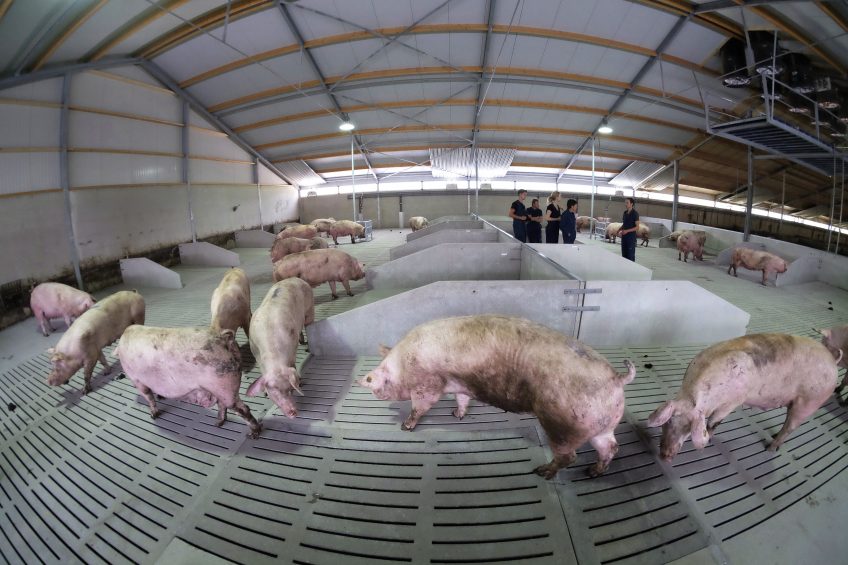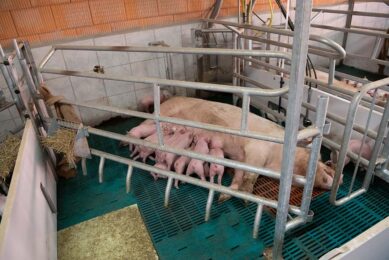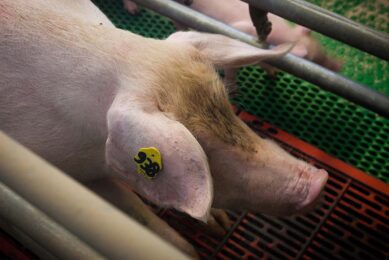11 reasons to embrace group housing for sows

Group housing for sows – for some countries it has been commonplace for many years, others are currently considering to convert. Time for a recap, there’s plenty of reasons to embrace the development, writes Pig Progress editor Vincent ter Beek.
This week, on 13 February, the 2nd edition of the Sow Housing Conference will take place, as a side event of the Ohio Pork Congress. Regular contributor to Pig Progress, welfare expert Dr Monique Pairis-Garcia, has been actively involved in organising the event. It is a topic for which interest worldwide continues to grow – the US conference may serve as a good example for that.
I’ve figured out that there are at least 11 reasons why group housing is a topic worth thinking about. Wherever I have more background information of have observed certain things in practice, I have not hesitated to link to other articles. Feel free to add more reasons if you know them!
 Dominant sows? No problem
Dominant sows? No problem
Let’s take a dive into history, my personal hobby. Why did the pig business invent gestation crates/ sow stalls in the first place? That was for 2 reasons as far as I know. First: in bigger groups, dominant sows would fight with timid ones, leading to fighting, stress and even abortion.
It is fair to say that in 2018 that reason is no longer valid. Yes, sows still fight, but knowledge about sow behaviour has moved on. It helps to understand why they fight (establishing hierarchy), how long they fight (usually a few days) and when there is chances for abortion (5-25 days after insemination). This pig breeder in the Netherlands usually sends his sows into groups straight after insemination.
Therefore, sending in sows into group housing straight after insemination or after a month usually prevents unwanted side effects. Plus, when group house zones are large enough and hiding places are being provided, more timid sows have possibilities to escape.
 Management difficult? Not any more
Management difficult? Not any more
2nd reason why gestation crates/ sow stalls were invented: it was better for management reasons. Sows locked up in crates could easily be approached, recognised and managed by humans than when they all mixed up in one room.
As time has moved on, so has technology. One could wonder if it is really necessary to keep them locked up all the time to manage them properly? And, one step further, is very regular physical presence of a pig breeder essential to observe the progress and well-being of the sow? The answer is no, twice – I will touch on examples later.
 Animal welfare is increased
Animal welfare is increased
‘Animal welfare’ is often the reason why changes towards group housing are set in motion – and the term leads to strong reactions, both positive and negative. Animal welfarists state it is inhumane to keep sows locked up most of their lives – a message that does reach consumers. It doesn’t always go well with people at home viewing images of sows in crates – however much this image might be distributed without context.
Quite frankly, I am not convinced that the reason why an increasing number of integrators around the globe are switching to group housing is totally down to animal welfare. It is more likely because many farms have learned that group housing for sows actually pays off.
 Many options to choose from
Many options to choose from
Conversion to group housing for sows isn’t just a simple thing. It needs a proper rethink of the breeding facilities and its strategy. Does a farm opt for a back-to-basic approach, a relatively simple adjustment to crates or go for a high-tech solution?
The back to basic approach would simply mean: get rid of most of the ‘iron’ in the gestation buildings and use floor feeding instead.

A 2nd option, often seen in e.g. Denmark, is free-access stalls. That is a combination of sow stalls with a loose housing area. Sows can stay inside a gestation crate if that is what they prefer – and if they want to walk, they can.
Most investments (in equipment as well as in staff training!) would require a conversion to Electronic Sow Feeding (ESF) systems, which come with ear tags, feeding stations that provide feed rations having read the ear tags, and if necessary selecting out the sows when it’s time to farrow. Just an example – here’s how this works on a French farm.
 Stress can be prevented!
Stress can be prevented!
Stress levels among sows can be prevented to a considerable degree. Sows can be helped to feel more at ease in group housing. Gilts can be ‘trained’ to understand the concept of group housing and feeding stations, so they are fully acquainted to the zones by the time they are ready for it.

In addition, farms can opt for stable or dynamic groups in group housing. In the first, sows gestate and farrow as one group, know each other, and will meet each other again after farrowing. Fights for establishing hierarchy are not needed as everybody already knows each other. Dynamic groups (where many sows in different stages of gestation are kept together) require more space but can often be more flexible in terms of planning.
 Economics: group housing isn’t worse
Economics: group housing isn’t worse
For those who are sceptical to move to group housing: quite a few researches, even in Northern America, have shown that at least group housing is not a step back in terms of technical results and performance.
This research from the University of Minnesota stated that it didn’t find any ‘consistent difference in productivity’. An overview by Prof John McGlone in 2013 reached similar conclusions. Another study at the Prairie Swine Centre in Saskatchewan, Canada in 2014 stated that good stockmanship is what is key to make group housing a success.
 Economics: better farrowing rates
Economics: better farrowing rates
OK – if technical results can be identical, why convert? One experience quite a few sow breeders have reported on, is that group housing better prepares sows for farrowing. By being able to walk around during the pregnancy, the animals are in a better shape for farrowing, as was confirmed for instance by Sébastien Menguy, owner of a farrow-to-finish farm in France. The farrowing process usually goes smoother than when using gestation crates, leading to lower piglet mortality figures around farrowing.
 Economics: Big Data management
Economics: Big Data management
A benefit not everyone may have seen from the start – but something that is now quickly catching on: the possibility of Big Data management. When breeders convert to ESF systems, the ear tagging does not only allow targeted feeding, it also allows targeted monitoring. In combination with smart software, sow breeders have gained incredible insight into feed and water consumption and weight gain.

In modern times, where computers and Big Data are offering increased amounts of possibilities, this allows for much better management than ever before – and potential problems can be tracked very early because of a changed feed consumption curve.
 Economics: Extension into farrowing
Economics: Extension into farrowing
It doesn’t stop there, however. When sows are equipped with ear tags, it is also possible to follow their feed and water consumption in the lactation house, like for instance in this UK farm. Thus, in combination with data gathered from the gestation house, sow breeders will have an almost 360º view of a sow’s performance throughout every cycle, offering even better insight into do’s and don‘ts.
 Economics: Precision feeding
Economics: Precision feeding
Increasingly more is known about the dietary requirements around parturition and lactation – read for instance contributions by Danish housing and welfare expert Vivi Aarestrup Moustsen or this contribution by Cargill Animal Nutrition.
Part of this already starts in the phase prior to the move to the farrowing room. When the feeding systems have been fully automated, like e.g. with Electronic Sow Feeding systems, there are better options to meet the sows’ dietary demands easier and to do so with more precision.
 Look around you
Look around you
Lastly, if all these reasons don’t sound convincing, then think about the following. Various leading pig countries around the world have already successfully converted to group housing. In the EU, conversion started in 2006 and was completed in 2013, with Denmark and other Scandinavian countries having even had experiences prior to that. What was initially started as a welfare-induced development, proved to open doors which led to additional advantages than was foreseen.
Also Smithfield announced the completion of the conversion – and recently large Thai agribusiness Betagro also announced to do so. Would they have really converted if there wasn’t something good about it?











